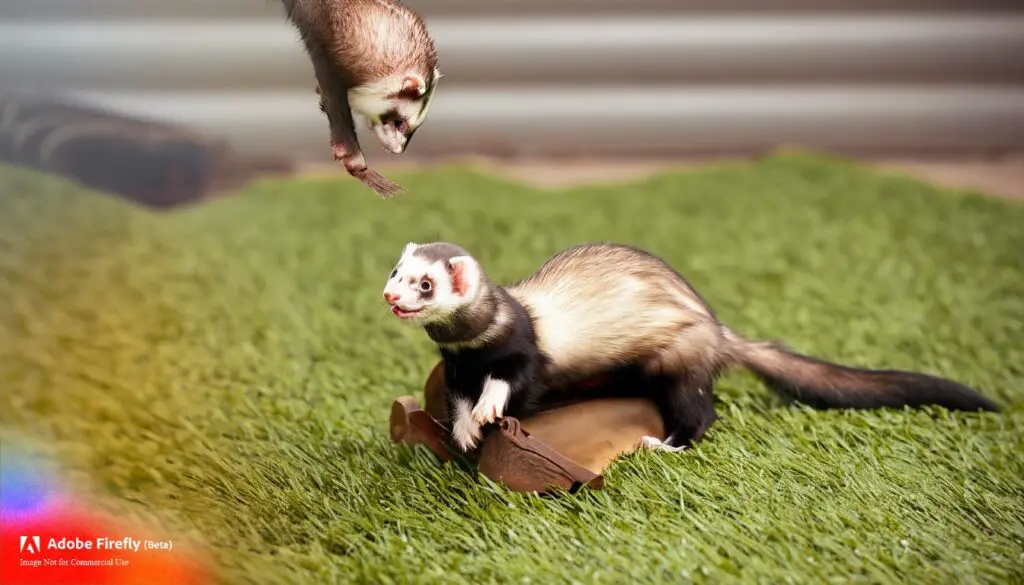
Probably the best thing about ferrets is playing with them. It’s impossible not to smile watching them scurry around like mad. Here are some tips to help you join in the fun.
You probably realize that ferrets are among the most social pets you can have. They want to be with you and they need to be out of their cage at least two hours every day – even more if you can manage it. This is true even if you have more than one ferret. While they thrive on having a ferret friend, they still need you.

Not sure what to do with your ferret? Why not start by just stroking it and letting it climb all over you? It’s an easy way to get to know each other. Try hiding a small treat (a bit of scrambled egg, a piece or two of dry ferret food etc.) in a pocket and let your ferret find it. You’ll find out the reason that the word “ferret comes from the Latin word for “thief”.
If you have space to do so, fill up a box with oatmeal, sand, packing peanuts – anything they can safely dig through. Just be sure they don’t eat whatever you use – it could cause severe intestinal trouble. You’ll probably have to vacuum the floor when playtime is done but it’s well worth the effort. Make sure also that your ferret didn’t mistake the play area for a litter box.
Another fun game is to create a maze of wrapping paper tubes, blocks and other objects. You’ll be amazed at how well they can squeeze through even seemingly tiny spaces, thanks to their flexible ribs. Maybe you can set up two identical courses for your ferrets and see which one gets through first.
A lot of ferret owners like to set up a permanent obstacle course in a large box or even a “ferret run”. Put a lot of toys like golf balls, dog and/or cat toys and other similar objects that are large enough and sturdy enough so that your pets won’t try to eat them and choke.
Playtime is fun, of course, but it can also be educational. You can use playtime to teach your ferret many useful skills. Start by teaching it to come when called. It’s really easy, especially if you make the effort to say the ferret’s name often when you’re playing together: (“Hi Freddy!” “You like that Freddy?” “What are you doing there Freddy?”).
Soon you’ll be able to call its name while offering a treat. (“Hey Freddy! Look what I have for you!”) Of course, give the treat when it comes promptly. Keep repeating this game until it has learned to associate its name with a treat. Start to withhold the treat if it seems to ignore you. Your ferret will soon get the idea that it’s better to come quickly.

Teaching your ferret to come when called makes it easier to stop bad behavior. Say its name and a firm “no!” when it nips or bites or starts to dig somewhere it shouldn’t.
Once your pet responds its name, you can start teaching it to walk on a leash. First, though, you’ll need to get it used to wearing a harness. Have your ferret come to you and sit on your lap while you get the harness on. Harnesses and leashes are available at most pet supply stores. You may need to try several styles to find the right one for your ferret.
At first, the ferret may balk at wearing such an ungainly contraption but if you offer a favorite toy or treat when it’s wearing the harness, it will soon become second nature.
Once it seems used to the harness, you can attach the leash. Hold on to the leash and walk a few steps forward. Offer the treat and let the ferret come to you. Walk a few more steps and offer another treat. Keep this up and your ferret will soon be very eager for a daily walk (or run).
The end of playtime is an excellent time for training in another important skill – using the litter box. You should train ferrets to “go” at the end of every playtime. Of course, you’ll want to have the litter box set up already. If it seems to have a favorite spot to do its business already, set up the litter box there. Otherwise find a convenient corner away from the feeding and sleeping areas in its cage.
Some people find it helpful to put immovable objects in every corner of the cage except the one for the litter box. At the end of playtime, set your ferret on the litter box and wait. If it uses it, offer a treat. If it doesn’t, withhold the treat. (You may need to be careful; some ferrets are good at faking it.) Within a few days, your ferret will get the idea.
These are just some of the basic skills ferrets can learn. You’re sure to develop your own games and ferret skills over time so you’ll enjoy your pet even more.






